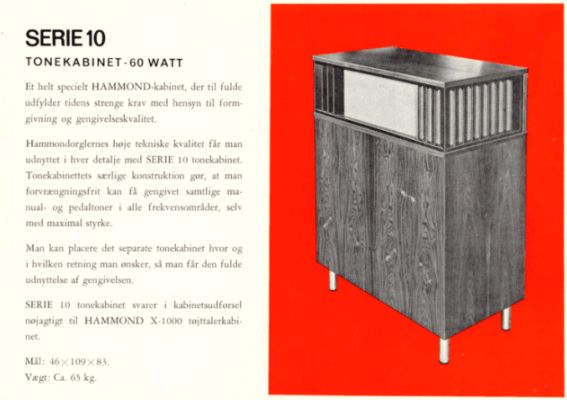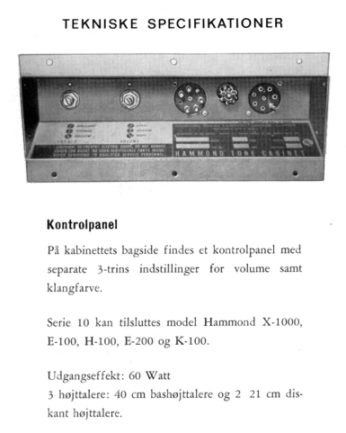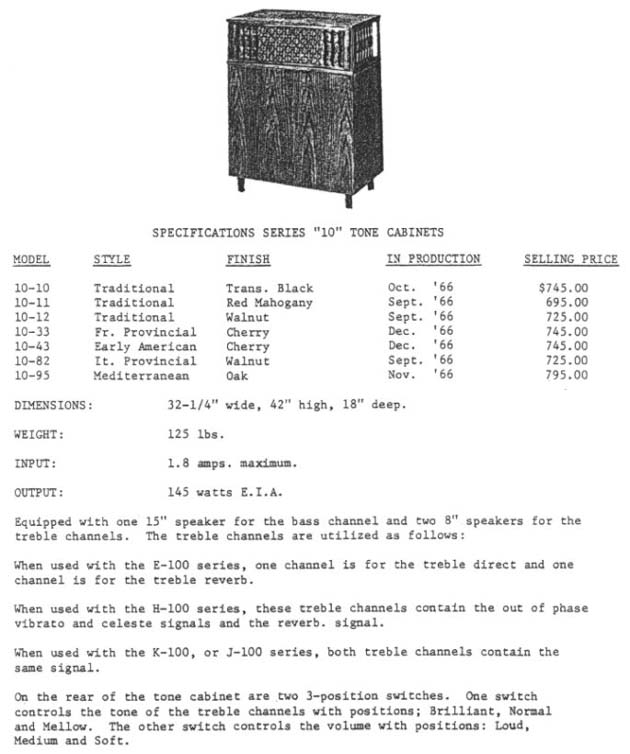![]()
The Series 10 Tone Cabinet - 60W of fun! This nifty 60's style cabinet was to be the successor to the aging design of the PR-40. The Series 10, however, did not have built in reverberation thus relying on the console reverberation of the newer Hammond organs such as E-100, H-100 (also X-1000 and HX-100 - the special versions of the H-1XX series) and T-100. The cabinet was essentially stereo with a derived bass channel; much like in the H-100 internal speaker system.
How the stereo was utilized depended on the organ the Series 10 was connected to. The H-100 had a stereo output with phase shifted signals derived from the dual scanner system inside the organ - i.e. the closest you can get to a 'true' stereo system. If you connected the Series 10 cabinet to an E-100 you would get 'treble direct' and 'treble reverb' in the two channels, much like in the older PR-cabinets. (I'm sure the Series 10 cab would work with older Hammonds such as A-100 and M-100 too).
The R-100 organ had a 'Main' and a 'Leslie' channel each with its own power amplifier inside the console. Both channels were connected to the Series 10 socket and either channel could have reverb, depending on the tab settings at the console. Normally the 'Leslie' channel was filtered, creating a sort of stereo effect, but if the 'Leslie Chorus' tab was selected, the signal fed to the 'Leslie' channel was the same as for the 'Main'.
The T-series spinets had an output socket for the Series 10 cabinet, but you would not get any stereo effect because the output from this type of organ is a mono signal, and the two channels would therefore simply be wired together (this does not include the T-500 series version which had a two channel output - but not for the Series 10 cabinet).
The interface from the organ to the Series 10 cab was the 'worst ever' as far as plugs and sockets are concerned. The system consisted of a 7-pin Amphenol plug with two pins removed and two holes in place of them, and a mating socket where two of the holes had been given two pins that stuck out and would mate with the two holes in the plug. One can only guess whether this was Hammond's last attempt to make the organs 'Leslie-safe'. At any rate, Leslie quickly made connector kits for this special 7-pin system so whatever plans they had at the Hammond offices in Chicago were not having much impact.
The pin-out of the Series 10 plug is described in the Leslie pin-outs section.
Ok now for some graphics. First a nice Danish brochure kindly scanned and supplied by Hans Wehner.


And here is a scan from the Hammond Service Manual, perhaps easier for the English speaking people out there to read than the other brochure. As it can be seen, the cabinet was available i various cabinet styles denoted with a two-digit number after the '10' model number. What escapes me is the fact that down below the cabinet is reported to have an output of 145W but in the other brochure it is only 60W. Maybe they mistakingly reported the power consumption as the output wattage.

The schematic for the cabinet be found on the schematics page